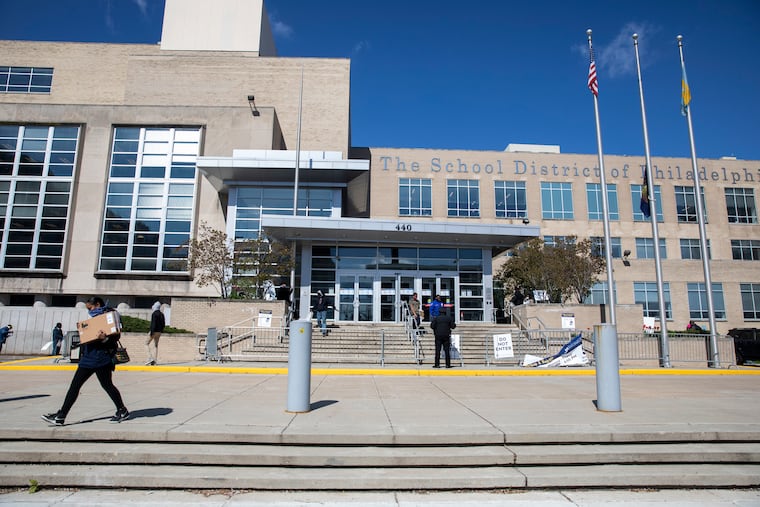Philly schools weigh reopening with a hybrid learning model, masks and cleanings every 4 hours
A final school reopening plan is expected next week. But in town halls over four days this week, school officials laid out where a combination of public health guidance, public feedback and their own teams’ planning have led them so far.

Philadelphia School District officials have signaled what a return to buildings amid the coronavirus outbreak is likely to look like this fall: a hybrid in-person and online learning model, no temperature checks for students and staff, and cleaning high-touch areas every four hours.
They also said they could prioritize some subjects for face-to-face instruction — English, math, science, art, music, and physical education — and teach other subjects virtually.
A final school reopening plan is expected next week, Superintendent William R. Hite Jr. said Thursday. But in town halls over four days this week, the school system’s chief medical officer, academic chief, interim facilities leader, and chief of schools laid out where a combination of public health guidance, public feedback, and their own teams’ planning have led them so far.
» READ MORE: ‘A lose-lose situation’: Schools try to plan their reopening amid conflicting coronavirus guidelines
The realities of Philadelphia buildings, some of which are overcrowded, with classrooms of 30 children or more, mean that not all of the district’s 125,000 students will be able to be in school at the same time, the superintendent said.
“We’re going to have to do this in shifts,” Hite said. “No question about it.”
Classes are scheduled to begin Aug. 31, but Hite has said the need for COVID-19 training and protocols could push that back.
Barbara Klock, a physician who became the district’s chief medical officer just before COVID-19 hit, said that when staff and students do return to school, they will wear masks but be given “mask breaks” when appropriate. School schedules may be changed to minimize interaction between groups of students. Children will sit at desks facing the same direction. And rather than taking temperatures each day to flag those who may be showing coronavirus symptoms, the district will rely on parents and staff to report temperatures.
“We thought long and hard about that,” said Klock. “I feared that by the time we got through all the temperature-taking, it would be time for lunch. We are keeping the education of our students extremely parallel with the health and safety of everyone involved.”
Klock also said that the district hopes as much as possible to provide students individual supplies of items like pencils, books, crayons, and calculators, but that if equipment must be shared, it will be sanitized between uses. Classrooms are likely to look different, too: Teachers will be asked to remove all rugs, curtains, and other cloth surfaces, which are difficult to sanitize frequently. Gym will be socially distanced, with children outside when practical, and art teachers will instruct students in their classrooms instead of the art room.
Officials promised that high-touch surfaces in schools will be disinfected every four hours, and that hand-washing and sanitizing will be emphasized throughout the day.
The tentative plans — particularly those around cleaning and sanitizing — were met with skepticism from members of the public who weighed in at the town halls, at which no questions were answered.
Some schools lack consistent hot water, soap, and toilet paper. And cleaning staffs have traditionally been stretched thin, with some schools routinely left dirty.
“Often, there’s only one person for an entire building, and cleaning is below minimum standards,” said teacher Arlana Tindle. “Often, only the trash is emptied — if that even happens. The schools were barely maintained before COVID.”
» READ MORE: Most Philly teachers say they want students physically back in class every other week
Alicia Prince, the district’s interim chief of facilities and capital programs, said the school system was working to fill existing cleaning positions and would add some new jobs. That’s a reversal from an earlier position; after the Philadelphia Federation of Teachers and a coalition of elected officials called for hundreds more cleaners, a district spokesperson said it had sufficient cleaning staff.
It was not immediately clear how many new cleaners the district would add to scrub and sanitize its 220 schools, with roughly 26 million square feet of space.
Hite, at his news briefing, said keeping schools clean would have to be a community effort.
“It’s going to take more than just cleaning staff doing these types of things,” he said. “We’re all going to have to do some things differently.”
School officials also said they would prioritize ventilation issues, a pressing need in schools where windows don’t open or air circulation is poor. The vast majority of district schools also lack air-conditioning.
Hite said Thursday that air circulation issues could render rooms, hallways, or even schools unfit for students and staff.
“If there are no windows that open in a room, no air-conditioning, no fan, that’s not a room that we’re going to be able to use,” he said.
The superintendent said there will be learning gaps — “children are off track. You can’t miss that many days and not be off track,” he said — but whatever form learning takes, teachers will need to focus on social-emotional learning, dealing with trauma, and reestablishing community.
He also said he was unmoved by President Donald Trump’s declaration that schools that don’t reopen fully could lose federal funds, which represent about 10% of the district’s budget.
“There’s no credibility there,” said Hite. “If there was credibility, there would have been guidance early on.”